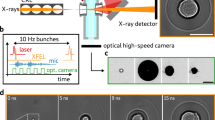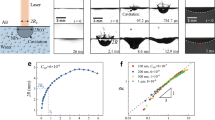Abstract
Under extreme acoustic stress, liquids can be caused to rupture, with the transient generation of a vapour cavity. The subsequent collapse of these cavities is normally violent enough to be observed with the unaided eye or ear, and often generates free radicals due to the high temperatures and pressures associated with the collapse. Flynn1 has calculated that microsecond pulses of ultrasound with peak intensities in the range 10–30 W cm−2 can generate transient cavitation in water. Because some diagnostic ultrasound systems2,3 now in clinical use generate microsecond length pulses with temporal peak intensities >100 W cm−2, there is reason to believe that this mechanism could operate in diagnostic conditions in aqueous media. We show here that ultrasonic pulses as short as one cycle at a frequency of 1.0 MHz give rise to luminescence flashes characteristic of violent cavitation. This provides the first experimental confirmation of Flynn's theoretical calculations.
This is a preview of subscription content, access via your institution
Access options
Subscribe to this journal
Receive 51 print issues and online access
$199.00 per year
only $3.90 per issue
Buy this article
- Purchase on Springer Link
- Instant access to full article PDF
Prices may be subject to local taxes which are calculated during checkout
Similar content being viewed by others

References
Flynn, H. G. J. acoust. Soc. Am. 72, 1926–1931 (1982).
Carstensen, E. L. & Flynn, H. G. Ultrasound Med. Biol. 8, 1720–1723 (1982).
Kremkau, F. W. Clinics Obstet. Gyn. 10, 395–401 (1983).
Roy, R. A., Atchley, A. A., Crum, L. A., Fowlkes, J. B. & Reidy, J. J. J. acoust. Soc. Am. (in the press).
Carstensen, E. L., Parker, K. J. & Barbee, D. B. J. acoust. Soc. Am. 74, 1057–1061 (1983).
Marston, P. L. & Unger, R. T. Shock Waves in Condensed Matter (Plenum, New York, in the press).
Jarman, P. J. acoust. Soc. Am. 32, 1459–1464 (1960).
Walton, A. J. & Reynolds, G. T. Adv. Phys. 33, 595–660 (1984).
Sehgal, C., Sutherland, R. G. & Verrall, R. E. J. phys. Chem. 84, 396–398 (1980).
Finch, R. D. Ultrasonics 1, 87–95 (1964).
White, E. H. & Roswele, D. F. Accts. chem. Res. 3, 54–61 (1970).
Burdo, E. G. & Seitz, W. R. Analyt. Chem. 47, 1643–1648 (1975).
Crum, L. A. & Reynolds, G. T. J. acoust. Soc. Am. 78, 137–139 (1985).
Crum, L. A. Appl. Sci. Res. 38, 101–111 (1982).
Evans, A. & Walder, D. N. Nature 222, 251–254 (1969).
McDonough, P. M. & Hemmingsen, E. A. J. appl. Physiol. 56, 513–521 (1984).
ter Haar, G. R. & Daniels, S. Phys. Med. Biol. 26, 1145–1150 (1981).
Berg, K. B., Child, S. Z. & Carstensen, E. L. Ultrasound Med. Biol. 9, 1448–1453 (1983).
Sommer, F. G. & Pounds, D. Med. Phys. 9, 1–11 (1982).
Williams, A. R. & Miller, D. L. Ultrasound Med. Biol. 6, 251–260 (1980).
Dyson, M. & Suckling, J. Physiotherapy. 64, 105–111 (1978).
Author information
Authors and Affiliations
Rights and permissions
About this article
Cite this article
Crum, L., Fowlkes, J. Acoustic cavitation generated by microsecond pulses of ultrasound. Nature 319, 52–54 (1986). https://doi.org/10.1038/319052a0
Received:
Accepted:
Issue Date:
DOI: https://doi.org/10.1038/319052a0
This article is cited by
-
Ultrasound Cavitation/Microbubble Detection and Medical Applications
Journal of Medical and Biological Engineering (2019)
-
Power density requirement of a 4 MHz micro-ultrasonic transducer for sonodynamic therapy
Biomedical Microdevices (2008)
-
Contributions of mechanical and sonochemical effects to cell membrane damage induced by single-shot pulsed ultrasound with adjacent microbubbles
Journal of Medical Ultrasonics (2008)
-
Visual Observation of a Sound-Induced Bubble in Liquid 3He–4He Mixtures
Journal of Low Temperature Physics (2007)
-
Cavitation phenomena in extracorporeal microexplosion lithotripsy
Shock Waves (1994)
Comments
By submitting a comment you agree to abide by our Terms and Community Guidelines. If you find something abusive or that does not comply with our terms or guidelines please flag it as inappropriate.


